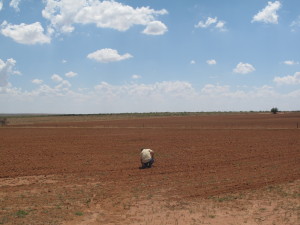Big data. These words have been swirling around coffee shops, field days, and agricultural press over the last couple of years. Recently, Shannon Ferrell and I wrote a paper discussing big data and drone use in agriculture. Because this is such an important topic, I thought I would do a three-part series on this issue in the coming weeks. Today, we will kick things off with the introductory question: What is big data?

Definition
One recent Forbes article addressed this issue and explained the confusion surrounding the term. The author, Lisa Arthur, then attempted to craft a one-sentence definition: “Big data is a collection of data from traditional and digital sources inside and outside your company that represent a source for ongoing discovery and analysis.” Todd Janzen, an agricultural law attorney who focuses on big data issues, defines the term as “the ability to aggregate information to discover trends and find patterns.”
Put simply, big data refers to the ability to collect and analyze large amounts of information. Today, technology allows producers to gather mountains of information about their own operations. From the farm equipment they run, to inputs applied, to crops they harvest, to even the soil on which they farm, the data seems unlimited. This data gathered on one farm is impressive enough, but when the potential to aggregate this type of data over hundreds of even thousands of farms is considered, the potential uses are more powerful than ever-before imagined. Just by way of a few examples, analyzing agricultural big data may allow producers to detect trends in seed variety performance, to better predict market trends, and to compare cultivation practices. This type of potential dataset collection is a prime illustration of what is meant by big data.
For more information on big data, check out the Farm Bureau Big Data Resources page.
Collection and Sharing
Several types of data may be collected on farms today. Todd Janzen has broken such data down into three main categories. First, agronomic data is information derived about activities and conditions on farm fields. This would include information about soil quality and crop yields, for example. Second, machine data is information associated with how farm equipment is functioning, such as fuel consumption and diagnostic codes. The third category is weather data, including information about precipitation, wind, and temperature. This data can be collected by a variety of tools, ranging from technology installed on farm equipment, to cell phones, to handled technological devices.
Oftentimes, when such data is collected, it is then shared with an agricultural technology provider (“ATP”) through an internet based cloud system. For example, a John Deere tractor might collect data while running in the field and automatically transmit such data to John Deere’s cloud.
Potential Advantages and Disadvantages
A with most technology, there are both advantages and disadvantages being touted by those on each side of the big data issue. Those favoring the use of big data argue that the ability to collect large datasets of information for analysis will greatly improve a farmer’s efficiency. By being able to access a greater volume and quality of information, agricultural operations could greatly benefit from the use of big data. Further, technology will allow farmers to quickly and nearly effortlessly communication with crop advisers and other consultants, who can, in turn, make instant recommendations for the producer. Another example of the usefulness of big data can be seen in John Deere’s ability to use data transmitted from tractors in the field to predict mechanical problems before they occur and, as a result, to dispatch a technician with the parts that will be necessary to the field before the first sign of trouble. Additionally, there are opportunities for producers to join together and share data, allowing more information and better analysis of issues. One example of this was highlighted in a recent article, “How Farmers Can Use Data To Push Back Against Big Ag.” The article offered an example of a farmer whose seed was under-performing. The seed company told him to just plant more seed. But because of a network of farmers sharing their data, he was able to see that none of the other farmers utilizing this seed had seen results promised by the company.
On the other side, opponents of the big data revolution argue that such data carries potential harms, not least of which is the disclosure of personally identifiable information to outside parties and a lack of understanding or agreement between data users about whom such information may be disclosed. For example, opponents fear that farmers names, addresses, social security numbers, and other personal information could be inadvertently given to third parties through the sharing of datasets with others. Unfortunately, it is not unrealistic to think that certain anti-agriculture organizations could affirmatively seek exactly this type of information. Recently, litigation arose after the Environmental Protection Agency disclosed thousands of farmers’ and ranchers’ names, home addresses, GPS coordinates, and personal contact information to several environmental organizations in response to a Freedom of Information Act request. Similarly, data could be sought by others seeking to use it against farmers, such as in litigation or in seeking to obtain a lease held by another farmer. Additionally, some have expressed concerns over big data being used to manipulate commodity markets.












